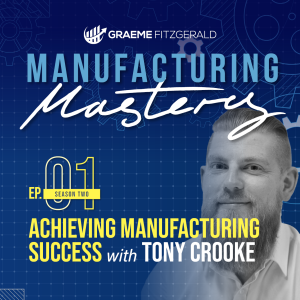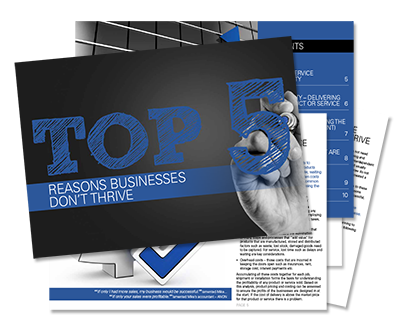THE SECRET BEHIND ONGOING PRODUCT SUCCESS
There’s often no better way to learn the secrets to manufacturing success than from a company that’s walking the walk and not just talking the talk.
Australian-owned computer and electronic company, GME, has been living the dream in manufacturing for over 60 years. What started in 1959 as one man repairing TV channels has grown to become the only Australian manufacturer of UHF CB Radios and Emergency Beacon products, holding significant market share.
In my latest Manufacturing Mastery podcast, I spoke with Tony Crooke, Group Marketing Manager for GME, who shared some insights into how they operate and what’s behind their ability to achieve ongoing product success.
DIRECTLY ENGAGING WITH CUSTOMERS
In his role as Group Marketing Manager at GME and his previous sales and customer service positions, Tony has always spent a lot of time dealing directly with customers, from social media to trade shows.
Because of this, he has the closest connection to them – something that offers an edge when developing Australian products. He knows what customers want and can feed this information at the PD stage.
By comparison, many manufacturing companies aren’t responsive to feedback, which can push customers away.
TIME TO VOLUME OVER TIME TO MARKET
Time to market is a buzz phrase that’s thrown around quite often. However, using this as an indicator of success isn’t necessarily a good thing.
In Tony’s experience, when you consider time to market in isolation, it can result in the product being rushed. In some cases, it means being brought to market before it’s truly ready. For example, it may not be delivering any true innovation or additional benefits to the customer. It’s just about hitting next month’s budget or knowing quarterly numbers. Ultimately, it’s a short term win.
It shouldn’t be ignored entirely in a competitive market like electronics, but time to volume is a concept that GME aligns with much more closely.
In support of this approach, they’ve implemented several processes in their business. These processes ensure they spend that little bit of extra time in the front end scoping and really developing differentiated products.
They know in a longer lifecycle industry like theirs, having a differentiated product (not necessarily the cheapest) that delivers some clear benefits to the customer will deliver more sustainable outcomes midterm.
A COLLABORATIVE APPROACH
When it comes to product development, GME uses a stage-gate approach. This means their PD takes place over several stages.
They have a cross-functional team called a Project Review Committee, made up of different stakeholders from different functions who review all ideas. They then vote on those ideas to see which ones will be put into action as a project immediately or held off. Very rarely do they kill an idea.
They also do a similar thing with potential markets. They have a holding area, which they keep going back to see whether factors within that market or technology have changed. This then affects the priority levels.
BALANCE INNOVATION + CONTINUOUS IMPROVEMENT
I asked Tony the difference between the buzzword ‘innovation’ and ‘continuous improvement’ and how they play out at GME.
How it works is that they have an innovation strategy and a technology strategy, which they quickly check in on quarterly and review more formally annually. This is to ensure they’re closely aligned to the demands and desires of their customer base within their existing areas. They also look at any new markets they’ve identified as potential targets.
While innovation is fantastic, they’re careful to balance this with not losing sight of their core customer base. This is where continuous improvement comes in. If they only constantly innovated, they’d risk damaging their solid foundations.
HAVE GOOD, LOCAL SUPPLIER RELATIONSHIPS
There have been endless supply chain issues over the years, which have affected many Australian manufacturers. This is something GME has been able to mitigate due to having robust supply chain processes in place.
Tony’s advice is to build and maintain strong relationships with your suppliers. It’s imperative to openly communicate with them and have that trust where you know you will be told any critical information before any new issues arise.
GME being an Australian manufacturer is one of their greatest benefits. It allows them to be agile with their production process and scheduling. When components are delayed, they have long lead times, in some cases over 60 weeks, to navigate these shortages.
DON’T LOSE SIGHT OF THE HUMAN ELEMENT IN MANAGEMENT
Last but not least, the biggest lesson and takeaway from GME when it comes to ongoing success is to invest in your people – from both a time and development perspective. Great businesses are only great when they have passionate and engaged employees driving them.
To achieve this, don’t lose sight of the human element in management and business. Talk to your people to ensure they know they’re valued, give them the tools they need to succeed and ask them, “If this was your business, what would you do?”
Nine times out of 10, says Tony, they will give you the correct response.
 To listen to the full conversation with myself and Tony, as well as other episodes, head to the Manufacturing Mastery podcast section of my website.
To listen to the full conversation with myself and Tony, as well as other episodes, head to the Manufacturing Mastery podcast section of my website.
Are you ready to be the next success story?

GETTING THE BASICS RIGHT
Pandemic or no pandemic - avoid the common traps that lead to business failure with this free e-book
Submit your details and you'll be given immediate access to download this FREE e-book.
